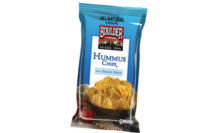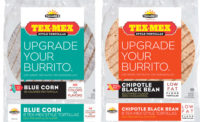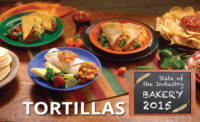
By Dan Malovany
When it comes to retail sales of tortillas, there’s no need for an economic stimulus package, although a tax rebate from the government never hurts. Sure, gas is creeping up toward $4.50 gallon, millions of mortgages are heading toward foreclosure, inflation is rising at a decade’s high rate and the stock market has slipped into a bear market.
People have to eat, right? Maybe that’s why around 70% of supermarket, C-store, wholesale club and mass merchandise operators describe the tortilla industry as “thriving” or “healthy,” according to an exclusive report on retail tortilla trends conducted by Snack Food & Wholesale Bakery magazine for the Tortilla Industry Association earlier this year.
Although the study was fielded in January, when oil was just around $100 a barrel, the positive outlook was mostly due to product innovation, Hispanic population demographic trends and a slew of merchandising efforts that will continue to fuel sales of packaged tortillas for the foreseeable future.
In fact, according to the survey, overall sales of tortillas in the retail channel are expected to increase by 50% over the next five years.
“It is important to note what is not happening regionally in the tortilla industry,” the report says. “The state of the retail tortilla industry is consistently healthy across all geographic regions. In other words, there is no region of the United States where things are better or worse than any other. This point is made because the U.S. Census Surveys of Tortilla Manufacturers shows concentration of tortilla manufacturing facilities in California, Texas and Colorado. Retail sales of tortillas, however, have a national consistency.”
On the downside, nearly 28% of retailers report a “stagnant” tortilla industry.
“The reasons for stagnant sales demonstrate the value of merchandising – 42% of retailers [who call the industry “stagnant”] say their slow sales are due to a lack of merchandising,” the report says.
For example, one retailer complained that there were “no new ideas for the use of tortillas and no new establishments selling tortillas.” Others noted that there was “too much production” in their region.
However, it’s important to stress that those opinions are in the minority. The reasons for a “thriving” or “healthy” tortilla industry in the retail channel are numerous. Consumer demand, especially among tortillas used as snacks, remains strong and is pushing up sales. In addition to the growing Hispanic population, the continued popularity of Mexican food is another factor for growth.
Moreover, tortillas are perceived as healthy. Multigrain and whole-wheat tortillas are being incorporated into many diets. Tortillas also are perceived as lower in carbs than other baked goods. Even kids and school lunch programs are putting tortillas into their diets, which bodes well for the future of the industry, the report says.Cautious Optimism
Although tortilla sales are increasing at a steady rate, retailers do have some reservations about the state of the economy.
Despite projections of 8.4% compound annual growth rate through 2012, retailers don’t have their heads in the sand.
“They are just as concerned as everyone about the usual suspects” such as energy, commodities and health care costs, the report says.
By weight, more than 432 million lb. of tortillas were sold at retail in the United States in 2007. This translates into 34 tortillas per year, or about three per month, for every man, woman and child in the nation. Or in terms of tortilla chips by weight, that adds up to 23 “servings” per year, or about four large bags, for every person in the country.
Corn tortillas are expected to increase at a 6.9% compound annual growth rate with white corn varieties leading the way. Burritos, wraps and enchiladas will rise at a 6.3% clip with burritos heading the charge. Fried tortillas, which are comprised mainly of chips, will jump at a 13.7% compound annual growth rate while wheat flour varieties are expected to bump up at a 9.0% rate, led by 100% whole wheat, flavored and conventional, enriched white flour varieties, the report says.
In 2007, corn tortillas were the market share leader with 49% of sales, followed by burritos, wraps and enchiladas at 21.7%, fried tortillas at 16.0% and wheat flour tortillas at 13.3%.
By 2012, however, the market share for corn tortillas is expected to slip to 45.9% and burritos, wraps and enchiladas down to 19.8% while wheat flour tortillas are projected to inch up to 13.8% and fried tortillas jump up to 20.5%.
America is definitely a nation of snackers.
To increase sales of corn tortillas, two-thirds of retailers mentioned some sort of merchandising efforts as point-of-purchase displays, sampling and cross merchandising.
“Cross merchandising is the key to increasing sales of tortillas,” one retailer explained.
“Just tie in tortillas to other foods,” said another in the survey.
Hot fresh tortillas also sparked sales in the retail arena.
In the burritos, wraps and enchiladas segments, innovation is the key to success. Specifically, breakfast items and grab-and-go products appeal to consumers.
“Burritos are healthy – a healthy snack for kids,” one retailer told the researchers.
As for fried tortillas, the lure is simple. “People love tortilla chips,” says an owner of a Midwest grocery chain with 44 years of retail experience. Sampling along with large displays and cross merchandising with salsa, cheese dips and nacho demonstrations proved successful in generating sales.
Providing meal solutions such as wraps has been an effective way to promote wheat flour tortillas, which are perceived as the most nutritious choice among consumers.
Overall, the state of the retail tortilla industry is in good shape and the opportunity for future growth seems likely. However, retailers stress that tortilla producers must continue to provide innovative merchandising programs to sustain the success that the industry has enjoyed for more than a decade.
Editor’s Note: For more information on this report, contact the Tortilla Industry Association at www.tortilla-info.com.



